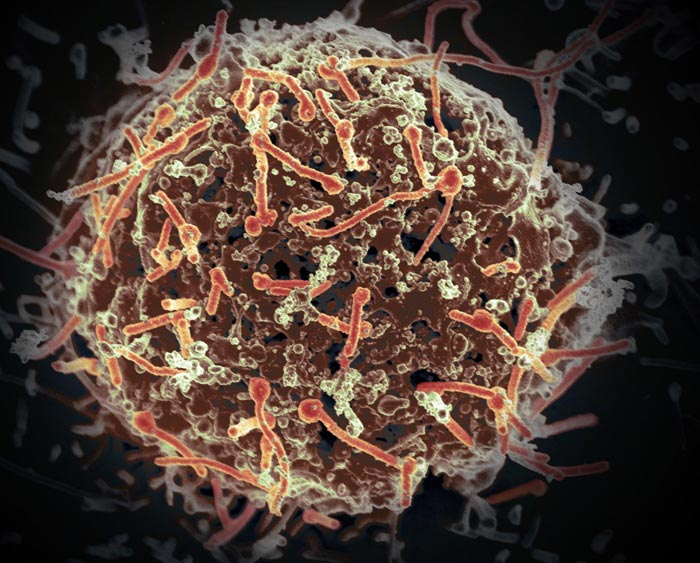NIH Ebola study in macaques provides timeframes for post-mortem viral stability

This is the Ebola virus, isolated in November 2014 from patient blood samples obtained in Mali. The virus was isolated on Vero cells in a BSL-4 suite at Rocky Mountain Laboratories. Credit: NIAID
The study, published in Emerging Infectious Diseases, suggests that Ebola transmission from deceased individuals may be possible for an extended period of time following death, underscoring the importance of using safe practices for handling corpses. The research also highlights oral swabbing of bodies as a reliable and safer alternative to riskier procedures for obtaining diagnostic samples.
To conduct this study, scientists at NIH's National Institute of Allergy and Infectious Diseases tested samples from five deceased macaques used in Ebola virus studies and euthanized after showing signs of disease. To assess the stability of the virus post-mortem, the scientists placed the bodies in a chamber to mimic environmental conditions in West Africa.
After the scientists sampled seven different body surfaces and removed tissue from four internal organs, they measured the amount of live Ebola virus and viral RNA, and compared test results at various times. The group determined that live virus was detectable in surface swabs up to seven days after death, and in the tissue samples up to three days post-mortem. Viral RNA was detectable in several swab and tissue types for up to 10 weeks.
The scientists believe these findings are likely to be consistent for non-human primates such as gorillas and monkeys. In fact, they designed the study to test animals found dead in the wild, but shifted the timing and emphasis to human implications related to the ongoing West Africa Ebola outbreak.
ARTICLE:
J Prescott et al. Post-mortem stability of Ebola virus. Emerging Infectious Diseases DOI: 10.3201/eid2105.150041 (2015).
WHO:
NIAID Director Anthony S. Fauci, M.D., and Vincent Munster, Ph.D., chief of the virus ecology unit in NIAID's Laboratory of Virology, are available to comment about this study.
CONTACT:
To schedule interviews, please contact Ken Pekoc, (301) 402-1663, kpekoc@niaid.nih.gov.
NIAID conducts and supports research–at NIH, throughout the United States, and worldwide–to study the causes of infectious and immune-mediated diseases, and to develop better means of preventing, diagnosing and treating these illnesses. News releases, fact sheets and other NIAID-related materials are available on the NIAID Web site at http://www.
About the National Institutes of Health (NIH):
NIH, the nation's medical research agency, includes 27 Institutes and Centers and is a component of the U.S. Department of Health and Human Services. NIH is the primary federal agency conducting and supporting basic, clinical, and translational medical research, and is investigating the causes, treatments, and cures for both common and rare diseases. For more information about NIH and its programs, visit http://www.
NIH…Turning Discovery Into Health®
Media Contact
All latest news from the category: Life Sciences and Chemistry
Articles and reports from the Life Sciences and chemistry area deal with applied and basic research into modern biology, chemistry and human medicine.
Valuable information can be found on a range of life sciences fields including bacteriology, biochemistry, bionics, bioinformatics, biophysics, biotechnology, genetics, geobotany, human biology, marine biology, microbiology, molecular biology, cellular biology, zoology, bioinorganic chemistry, microchemistry and environmental chemistry.
Newest articles

Bringing bio-inspired robots to life
Nebraska researcher Eric Markvicka gets NSF CAREER Award to pursue manufacture of novel materials for soft robotics and stretchable electronics. Engineers are increasingly eager to develop robots that mimic the…

Bella moths use poison to attract mates
Scientists are closer to finding out how. Pyrrolizidine alkaloids are as bitter and toxic as they are hard to pronounce. They’re produced by several different types of plants and are…

AI tool creates ‘synthetic’ images of cells
…for enhanced microscopy analysis. Observing individual cells through microscopes can reveal a range of important cell biological phenomena that frequently play a role in human diseases, but the process of…





















